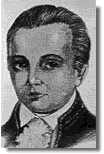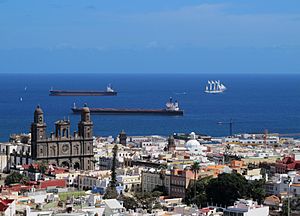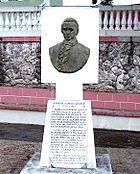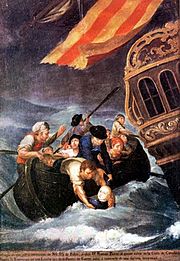Ramón Power y Giralt facts for kids
Quick facts for kids
Ramón Power y Giralt
|
|
|---|---|

Captain Ramón Power y Giralt
|
|
| Born | October 7, 1775 San Juan, Puerto Rico, Viceroyalty of New Spain |
| Died | June 10, 1813 (aged 37) Cadiz, Spain |
| Buried | |
| Allegiance | Spanish Navy |
| Years of service | 1795-1809 |
| Rank | Naval Captain |
| Battles/wars | Santo Domingo against an invasion from French forces |
Captain Ramón Power y Giralt (born October 7, 1775 – died June 10, 1813) was an important figure in Puerto Rican history. He was one of the first people born in Puerto Rico to call himself a "Puerto Rican." He worked hard to make sure Puerto Rico had a fair voice in the Spanish government. He served in the Cortes of Cádiz, which was like Spain's parliament at the time.
Contents
Early Life and Education
Ramón Power y Giralt was born in San Juan, Puerto Rico. His father, Joaquín Power y Morgan, was from Spain's Basque Country. His mother, María Josefa Giralt y Santaella, was from Barcelona, Spain.
His family had Irish roots. His great-grandfather, Peter Power, was from Waterford, Ireland. He moved to France, and his son later settled in Spain.
Ramón went to a private school in San Juan for his early education. When he was 13, in 1788, he traveled to Bilbao, Spain. There, he continued his studies.
When Ramón was 16, he began studying naval sciences in Spain. After finishing his studies, he became a lieutenant in the Spanish Navy. He eventually rose through the ranks to become a Captain.
In 1808, Napoleon Bonaparte invaded Spain. This led to a revolt in Santo Domingo (now the Dominican Republic) against French rule. Ramón Power y Giralt, along with Colonel Rafael Conti, helped defend the Spanish colony of Santo Domingo. They worked with Great Britain and Haiti to create a blockade. This helped return Santo Domingo to Spanish control.
A Career in Politics
In 1809, Spain was fighting against Napoleon's forces. Ramón Power was chosen to represent Puerto Rico in the Spanish government. This group was called the Junta Suprema Central y Gubernativa del Reino.
The next year, in 1810, he was again chosen to represent Puerto Rico. This time, it was in the Cortes of Cádiz. This was a special assembly that governed Spain while the king was away. Bishop Juan Alejo de Arizmendi was a big supporter of Power. He gave Power his own episcopal ring as a reminder to always remember his home country.
Power arrived in Cádiz on June 8, 1810. He quickly became an important voice for Puerto Rico. On September 25, 1810, he was elected as vice-president of the Cortes. He worked hard to improve Puerto Rico's economy. The Cortes also created the Constitution of 1812.
Before the Constitution was finished, Power convinced the Cortes to change a rule. This rule had given the governor of Puerto Rico too much power. His most famous achievement was the Ley Power (the "Power Act"). This law opened five ports in Puerto Rico for free trade. These ports were in Fajardo, Mayagüez, Aguadilla, Cabo Rojo, and Ponce.
The law also lowered many taxes and ended a monopoly on flour. These changes helped Puerto Rico's economy grow. Many of these reforms stayed in place even after the king returned to power.
Death and Legacy
Ramón Power y Giralt died in Cádiz on June 10, 1813. He passed away from a yellow fever outbreak that affected many parts of Europe. He was buried in the Oratorio de San Felipe Neri church in Cádiz.
Return of His Remains

In 2013, a special effort was made to bring Power's remains back to Puerto Rico. The Archbishop of San Juan, Roberto González Nieves, led this movement. Power's remains were dug up from the church in Cádiz.
After DNA tests confirmed his identity, his remains were placed on the Spanish tall ship Juan Sebastián Elcano. The ship left Cádiz on March 2, 2013. It sailed across the Atlantic Ocean for 28 days.
On April 6, 2013, the ship arrived in San Juan, Puerto Rico. The United States Coast Guard escorted it into the port. A 21-gun salute honored his return. The Governor of Puerto Rico and other important leaders were there to welcome him.
Today, Ramón Power y Giralt rests at the Cathedral of San Juan Bautista. He is buried next to Bishop Juan Alejo de Arizmendi, his loyal supporter.
Honors and Tributes

Both Puerto Rico and Spain have honored Ramón Power's memory. Several streets and avenues are named after him. In San Juan, there is a school called "Ramon Power y Giralt School." The city of Ponce also has a street named in his honor.
His old home in Old San Juan has been restored. It now houses the Puerto Rico Conservation Trust. The famous artist José Campeche painted a work called The Shipwreck of Power in his honor. Graphic artist Lorenzo Homar has also created art dedicated to Ramón Power.
See also
 In Spanish: Ramón Power para niños
In Spanish: Ramón Power para niños
- List of Puerto Ricans
- Irish immigration to Puerto Rico
- List of Puerto Rican military personnel


